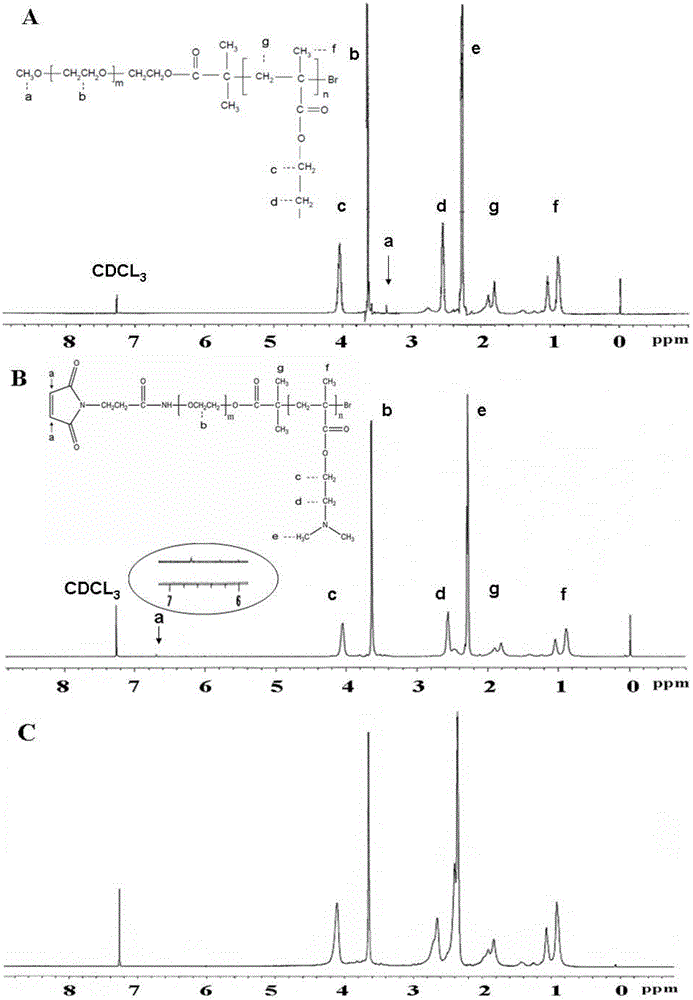A brain-targeted gene delivery system based on polymethacrylate
A polymethacrylate, brain-targeted technology, applied in the biological field, can solve the problems affecting the application potential of gene delivery, and achieve the effects of increasing transfection efficiency and expression level, good application prospects, and controllable degree of modification.
- Summary
- Abstract
- Description
- Claims
- Application Information
AI Technical Summary
Problems solved by technology
Method used
Image
Examples
Embodiment 1
[0073] Add 2mmol of methoxy-polyethylene glycol (Me-PEG), 20ml of CH 2 Cl 2 , 1mlTEA, cooled in an ice-water bath, mixed 8.37mol of 2-bromoacetobutyryl bromide with 20ml of CH 2 Cl 2 After mixing, it was slowly added dropwise into a four-neck flask, and the addition was completed in 30 minutes, and reacted at room temperature for 48 hours to generate MPEG-Br.
[0074] In the vacuum reactor A, add the complexing agent bipyridine, vacuumize, under N 2 Add catalyst copper bromide (CuBr) and DMAEMA under protection, magnetically stir, cool with liquid nitrogen, vacuumize - pass N 2 , repeated three times. Initiator (MPEG-Br), solvent isopropanol and water are added to vacuum reactor B, cooled by liquid nitrogen, vacuumed - N 2 , repeated three times. Then melt the contents of the two reactors A and B at room temperature, transfer the initiator solution in B to A with a sampler, cool with liquid nitrogen, evacuate - pass N 2 , repeated three times. Complete the deaeration s...
Embodiment 2
[0079] Dissolve 2.0 mg of the prepared MePEG-PDMAEMA and Maleimide-PEG-PDMAEMA in 0.5ml of deuterated chloroform, identify the structure of the carrier material with a 400MHz superconducting nuclear magnetic resonance spectrometer, and obtain the nuclear magnetic resonance spectrum. The results are shown in the attached figure 1 . After the reaction of PDMAEMA and Me-PEG, the characteristic absorption peak of methoxy group appeared at 3.4ppm, and the characteristic absorption peak of polyethylene glycol appeared at 3.6ppm, indicating that Me-PEG was successfully modified on PDMAEMA (ie MePEG-PDMAEMA) Simultaneously, after PDMAEMA reacted with Maleimide-PEG, in addition to the characteristic absorption peak of polyethylene glycol appeared at 3.6ppm, the characteristic absorption peak of maleimide group also appeared at 6.7ppm, indicating that Maleimide-PEG was successfully connected onto PDMAEMA (ie Maleimide-PEG-PDMAEMA).
Embodiment 3
[0081] Precisely weigh an appropriate amount of lyophilized Maleimide-PEG-PDMAEMA, dissolve it in PBS (pH7.0), and prepare a stock solution with a nitrogen atom concentration of 100nmol / μL; at the same time, prepare a pH7.0 PBS stock solution of the brain-targeting functional group TGN , the concentration is 100nmol / μL containing cysteine. Measure equal volumes of the two stock solutions into vials and stir at room temperature for 4 h. The maleimide group specifically binds to the sulfhydryl group on cysteine to form TGN-PEG-PDMAEMA. Dissolve 2.0mg of the prepared TGN-PEG-PDMAEMA gene delivery carrier in 0.5ml of deuterated chloroform, and identify its structure with a 400MHz superconducting nuclear magnetic resonance spectrometer. The results are shown in the attached figure 1 . After the reaction of Maleimide-PEG-PDMAEMA with brain-targeting functional group TGN, the characteristic absorption peak of maleimide group at 6.7ppm disappeared, indicating that TGN was successf...
PUM
 Login to View More
Login to View More Abstract
Description
Claims
Application Information
 Login to View More
Login to View More - R&D
- Intellectual Property
- Life Sciences
- Materials
- Tech Scout
- Unparalleled Data Quality
- Higher Quality Content
- 60% Fewer Hallucinations
Browse by: Latest US Patents, China's latest patents, Technical Efficacy Thesaurus, Application Domain, Technology Topic, Popular Technical Reports.
© 2025 PatSnap. All rights reserved.Legal|Privacy policy|Modern Slavery Act Transparency Statement|Sitemap|About US| Contact US: help@patsnap.com



